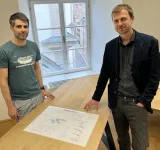(Press-News.org) BIRMINGHAM, Ala. – Neuropathic pain — abnormal hypersensitivity to stimuli — is associated with impaired quality of life and is often poorly managed. Estimates suggest that 3 percent to 17 percent of adults suffer from neuropathic pain, including a quarter of people with diabetes and a third of people with HIV.
In a paper published in the journal Neuron, researchers report that a mechanism involving the enzyme Tiam1 in dorsal horn excitatory neurons of the spinal cord both initiates and maintains neuropathic pain. Moreover, they show that targeting spinal Tiam1 with anti-sense oligonucleotides injected into the cerebrospinal fluid effectively alleviated neuropathic pain hypersensitivity.
“Thus, our study has uncovered a pathophysiological mechanism that initiates, transitions and sustains neuropathic pain, and we have identified a promising therapeutic target for treating neuropathic pain with long-lasting consequences,” said Lingyong Li, Ph.D., an associate professor at the University of Alabama at Birmingham Department of Anesthesiology and Perioperative Medicine. “Understanding the pathophysiological mechanisms underlying neuropathic pain is critical for developing new therapeutic strategies to treat chronic pain effectively.”
Li and Kimberley Tolias, Ph.D., a professor at Baylor College of Medicine in Houston, Texas, were co-leaders of the research.
It was known that one feature of neuropathic pain is maladaptive changes in neurons of the spinal dorsal horn — increases in the size and density of dendritic spines, the primary postsynaptic sites of excitatory synapses. However, the mechanisms driving this synaptic plasticity were unclear. Dendrites are tree-like appendages attached to the body of a neuron that receive communications from other neurons. The spinal dorsal horn is one of the three gray columns of the spinal cord.
In related work, Li and Tolias last year found that chronic pain in a mouse model leads to an activated Tiam1 in anterior cingulate cortex pyramidal neurons of the brain, resulting in an increased number of spines on the neural dendrites. This higher spine density increased the number of connections, and the strength of those connections, between neurons, a change known as synaptic plasticity. Those increases caused hypersensitivity and were associated with chronic pain-related depression in the mouse model.
The current neuropathic pain study by Li and Tolias used mouse models of neuropathic pain caused by nerve injury, chemotherapy or diabetes. The researchers showed that Tiam1 is activated in the spinal dorsal horn of mice subjected to neuropathic pain and that global knockout of Tiam1 in mice prevented the development of neuropathic pain. Global knockout causes no other apparent abnormalities in the mice.
The UAB and Baylor researchers found that Tiam1 expression in the spinal dorsal horn neurons — but not in the dorsal root ganglion neurons or excitatory forebrain neurons — was essential for the development of neuropathic pain. Furthermore, they found that neuropathic pain development depended on Tiam1 expression in excitatory neurons — not in inhibitory neurons.
After showing where Tiam1 acts in neuropathic pain, Li, Tolias and colleagues showed what Tiam1 does. Tiam1 is known to modulate the activity of other proteins that help build or unbuild the cytoskeletons of cells, and the building of cytoskeleton actin filaments is part of dendritic spine creation. The researchers found that Tiam1 is necessary during the development of neuropathic pain to increase the density of dendritic spines on wide dynamic range neurons from the spinal dorsal horn and to increase synaptic NMDA receptor activity of spinal dorsal horn neurons.
Tiam1 functions to activate the small GTPase Rac1 enzyme that promotes actin polymerization. The researchers showed that the development of Tiam1-mediated neuropathic pain was dependent on Tiam1-Rac1 signaling. They then used a small molecule inhibitor to block Rac1 activation at three different time points — right after peripheral nerve injury, four days after nerve injury when neuropathic pain hypersensitivity gradually develops, or three weeks after nerve injury when chronic neuropathic pain is fully established. They found that neuropathic pain was prevented or reversed at each time point. Thus, Tiam1-Rac1 signaling is essential for the initiation, transition and maintenance of neuropathic pain.
Since Tiam1 appeared to be a promising therapeutic target for treating neuropathic pain, Li and Tolias also tested whether they could reduce neuropathic pain by injecting antisense oligonucleotides, or ASOs — short, synthetic, single-stranded oligodeoxynucleotides designed to alter Tiam1 expression by modulating its mRNA processing or degradation — into the cerebrospinal fluid of the spine.
In a rat model, they found that injecting an ASO against Tiam1 decreased Tiam1 protein levels in the spinal dorsal horn by 50 percent and significantly reduced neuropathic pain hypersensitivity one week after injection, a reduction that lasted another two weeks.
Therefore, Tiam1 is an essential player in the pathogenesis of neuropathic pain that coordinates actin cytoskeletal dynamics, dendritic spine morphogenesis and synaptic receptor function in spinal dorsal horn excitatory neurons in response to nerve damage, Li and Tolias say.
The two researchers are corresponding authors of the study, “Tiam1 coordinates synaptic structural and functional plasticity underpinning the pathophysiology of neuropathic pain.”
Co-authors are Qin Ru, Yungang Lu, Xing Fang and Ali Bin Saifullah, Baylor College of Medicine; Guanxing Chen, University of Texas MD Anderson Cancer Center, Houston, Texas; and Changqun Yao, UAB Department of Anesthesiology and Perioperative Medicine.
Support came from the United States Department of Defense grant W81XWH-20-10790, the Mission Connect/TIRR Foundation, and National Institutes of Health grants NS062829 and NS124141.
At UAB, Anesthesiology and Perioperative Medicine is a department in the Marnix E. Heersink School of Medicine.
END
Neuropathic pain: The underlying mechanism and a potential therapeutic target are revealed in mice
Uncovering a pathophysiological mechanism that initiates, transitions and sustains neuropathic pain holds promise for treating neuropathic pain.
2023-05-04
ELSE PRESS RELEASES FROM THIS DATE:
Breast cancer tumors disrupt the immune system remotely favoring their own growth
2023-05-04
Researchers at Baylor College of Medicine and collaborating institutions have identified a strategy cancerous tumors use to remotely disrupt the development of an immune response that could stop their growth.
Published in the journal Cell Stem Cell, the study shows in animal models that breast cancer tumors send molecular signals to the bone marrow, the birthplace of immune cells. The signals alter the natural environment of the bone marrow in such a way that it suppresses the response to fight back the tumor. Interestingly, ...
Young men at highest risk of schizophrenia linked with cannabis use disorder
2023-05-04
Young men with cannabis (marijuana) use disorder have an increased risk of developing schizophrenia, according to a study led by researchers at the Mental Health Services in the Capital Region of Denmark and the National Institute on Drug Abuse (NIDA) at the National Institutes of Health. The study, published in Psychological Medicine, analyzed detailed health records data spanning 5 decades and representing more than 6 million people in Denmark to estimate the fraction of schizophrenia cases that could be attributed ...
Adherence to lifestyle recommendations and breast cancer recurrence prevention
2023-05-04
About The Study: In this observational study of 1,340 women with high-risk breast cancer, strongest collective adherence to cancer prevention lifestyle recommendations was associated with significant reductions in disease recurrence and mortality. Education and implementation strategies to help patients adhere to cancer prevention recommendations throughout the cancer care continuum may be warranted in breast cancer.
Authors: Rikki A. Cannioto, Ph.D., Ed.D., of the Roswell Park Comprehensive ...
Association of biomarker-based AI with risk of racial bias in retinal images
2023-05-04
About The Study: Results of this diagnostic study including 4,095 retinal fundus images collected from 245 neonates suggest that it can be very challenging to remove information relevant to self-reported race from fundus photographs. As a result, AI algorithms trained on fundus photographs have the potential for biased performance in practice, even if based on biomarkers rather than raw images. Regardless of the methodology used for training AI, evaluating performance in relevant subpopulations is critical.
Authors: J. ...
Cellular traffic controllers caught managing flow of signals from receptors
2023-05-04
Proteins that act like air traffic controllers, managing the flow of signals in and out of human cells, have been observed for the first time with unprecedented detail using advanced microscopy techniques.
Described in new research published today in Cell, an international team of researchers led by Professor Davide Calebiro from the University of Birmingham has seen how beta-arrestin, a protein involved in managing a common and important group of cellular gateways, known as receptors, works.
Beta-arrestin is involved in controlling the activity of G protein-coupled receptors (GPCRs) which are the largest group of receptors ...
Gene Tiam1 orchestrates the development of chronic neuropathic pain
2023-05-04
Neuropathy is a type of chronic pain triggered by nerve injury or certain diseases. It affects millions of people worldwide, significantly deteriorating their quality of life. Neuropathy, for example, might emerge from hurting the sciatic nerve on the lower back or the spinal cord, in diseases like rheumatoid arthritis and diabetes or after chemotherapy drugs. Current therapies attempt to suppress the symptoms with pain medications like opioids, but their efficacy is low, and they carry undesirable side effects.
A group led by researchers at Baylor College of Medicine and University of Alabama at Birmingham took on the challenge of investigating the process ...
The future of data storage lies in DNA microcapsules
2023-05-04
Storing data in DNA sounds like science fiction, yet it lies in the near future. Professor Tom de Greef expects the first DNA data center to be up and running within five to ten years. Data won’t be stored as zeros and ones in a hard drive but in the base pairs that make up DNA: AT and CG. Such a data center would take the form of a lab, many times smaller than the ones today. De Greef can already picture it all. In one part of the building, new files will be encoded via DNA synthesis. Another part will contain large fields of capsules, each capsule packed with a file. A robotic arm will remove a capsule, read its contents and place it back.
We’re talking about synthetic ...
Quantum computer in reverse gear
2023-05-04
Today's computers are based on microprocessors that execute so-called gates. A gate can, for example, be an AND operation, i.e. an operation that adds two bits. These gates, and thus computers, are irreversible. That is, algorithms cannot simply run backwards. “If you take the multiplication 2*2=4, you cannot simply run this operation in reverse, because 4 could be 2*2, but likewise 1*4 or 4*1,” explains Wolfgang Lechner, professor of theoretical physics at the University of Innsbruck. If this were possible, however, it would be feasible ...
Seizure discoveries advance efforts to develop better treatments
2023-05-04
New University of Virginia School of Medicine insights into how the brain responds to seizures could facilitate the development of much-needed treatments for the third of patients who don’t respond to existing options.
The research, from the labs of UVA’s Ukpong B. Eyo, PhD, and Edward Perez-Reyes, PhD, suggests that immune cells called microglia play important, beneficial roles in controlling various types of seizures. Prior research had left scientists uncertain whether these cells were helpful or harmful during the brain’s ...
Taylor & Francis set to open over 50 book titles with Knowledge Unlatched
2023-05-04
Taylor & Francis is delighted to announce the results of Knowledge Unlatched (KU) 2023, with support pledged to convert over 50 book titles to open access (OA). Titles to benefit from this support cover a broad range of humanities and social science disciplines as well as key topic areas, including climate change, global health, and gender studies.
Under the KU crowdfunding model, research libraries around the world unite to support the publication costs of new eBooks and enable access for all to important new research. Since 2016, when Taylor & Francis’ partnership with Knowledge Unlatched began, over 100 books have been published OA at no cost ...
LAST 30 PRESS RELEASES:
Plant hormone allows lifelong control of proteins in living animal for first time
Swedish freshwater bacteria give new insights into bacterial evolution
Global measures consistently underestimate food insecurity; one in five who suffer from hunger may go uncounted
Hidden patterns of isolation and segregation found in all American cities
FDA drug trials exclude a widening slice of Americans
Sea reptile’s tooth shows that mosasaurs could live in freshwater
Pure bred: New stem cell medium only has canine components
Largest study of its kind highlights benefits – and risks – of plant-based diets in children
Synergistic effects of single-crystal HfB2 nanorods: Simultaneous enhancement of mechanical properties and ablation resistance
Mysterious X-ray variability of the strongly magnetized neutron star NGC 7793 P13
The key to increasing patients’ advance care medical planning may be automatic patient outreach
Palaeontology: Ancient tooth suggests ocean predator could hunt in rivers
Polar bears may be adapting to survive warmer climates, says study
Canadian wildfire smoke worsened pediatric asthma in US Northeast: UVM study
New UBCO research challenges traditional teen suicide prevention models
Diversity language in US medical research agency grants declined 25% since 2024
Concern over growing use of AI chatbots to stave off loneliness
Biomedical authors often call a reference “recent” — even when it is decades old, analysis shows
The Lancet: New single dose oral treatment for gonorrhoea effectively combats drug-resistant infections, trial finds
Proton therapy shows survival benefit in Phase III trial for patients with head and neck cancers
Blood test reveals prognosis after cardiac arrest
UBCO study finds microdosing can temporarily improve mood, creativity
An ECOG-ACRIN imaging study solves a long-standing gap in metastatic breast cancer research and care: accurately measuring treatment response in patients with bone metastases
Cleveland Clinic presents final results of phase 1 clinical trial of preventive breast cancer vaccine study
Nationally renowned anesthesiology physician-scientist and clinical operations leader David Mintz, MD, PhD, named Chair of the Department of Anesthesiology at the UM School of Medicine
Clean water access improves child health in Mozambique, study shows
Study implicates enzyme in neurodegenerative conditions
Tufts professor named Fellow of the National Academy of Inventors
Tiny new device could enable giant future quantum computers
Tracing a path through photosynthesis to food security
[Press-News.org] Neuropathic pain: The underlying mechanism and a potential therapeutic target are revealed in miceUncovering a pathophysiological mechanism that initiates, transitions and sustains neuropathic pain holds promise for treating neuropathic pain.



